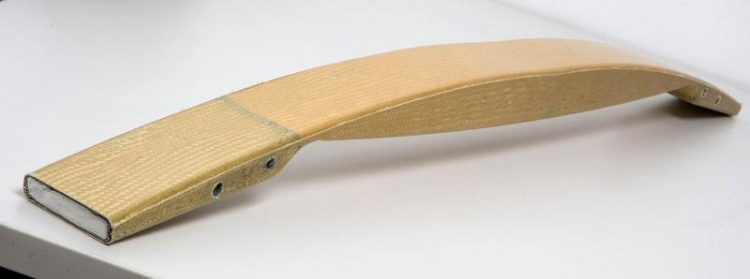New technology for mass-production of complex molded composite components

A composite part made by the PulPress method from a structural foam core ROHACELL® woven around with fibers is about 75 percent lighter than traditional steel structures. Evonik
The automotive industry is increasingly looking to composite materials as a way of reducing vehicle weight and CO2 emissions. Up to now, however, these materials have mostly been used in luxury-class vehicles, as established methods are expensive and complex.
With Evonik’s newly developed PulPress method, however, things are different: now manufacturers can mass-produce complex molded parts at a reasonable price, taking the technology from the high-end market to large-scale production.
The new method combines two traditional production techniques: compression molding and pultrusion. Combined together, they make automated, continuous production of composite parts possible. The most important raw material in the process is ROHACELL®, a high-performance structural foam core from Evonik that has already proven its merit as a lightweight yet rigid material—one that retains its shape particularly well and is temperature resistant.
Fibers are woven around the core before being impregnated with resin. The complete system is then compressed into the desired shape at high temperature and pressure. The method even allows manufacturers to produce complex geometries and integrate recessed areas for threaded components or other fixtures.
Particularly impressive aspects of the new manufacturing process include its design flexibility and cost efficiency, and the crash behavior of the resulting composite parts—parts that are around 75 percent lighter than traditional steel structures. Plus, the PulPress method also reduces costs by up to 60 percent compared to composite parts manufactured using established methods such as resin injection.
“These advantages have already won over a large number of customers in the European automotive industry,” says Dr. Sivakumara Krishnamoorthy, manager for new applications in Evonik’s Resource Efficiency Segment. “Molded parts made using PulPress will soon be going into mass production.”
The process is also of interest to manufacturers outside of the auto industry. It could conceivably be applied in aircraft construction as a cost-effective method for producing large numbers of carry-over parts. Finally, lightweight sandwich cores are also becoming more and more important in sports equipment.
Find out more about the PulPress method at JEC World, March 14 – 16, 2017, in Paris, Hall 5A, H44.
Media Contact
All latest news from the category: Process Engineering
This special field revolves around processes for modifying material properties (milling, cooling), composition (filtration, distillation) and type (oxidation, hydration).
Valuable information is available on a broad range of technologies including material separation, laser processes, measuring techniques and robot engineering in addition to testing methods and coating and materials analysis processes.
Newest articles

First-of-its-kind study uses remote sensing to monitor plastic debris in rivers and lakes
Remote sensing creates a cost-effective solution to monitoring plastic pollution. A first-of-its-kind study from researchers at the University of Minnesota Twin Cities shows how remote sensing can help monitor and…

Laser-based artificial neuron mimics nerve cell functions at lightning speed
With a processing speed a billion times faster than nature, chip-based laser neuron could help advance AI tasks such as pattern recognition and sequence prediction. Researchers have developed a laser-based…

Optimising the processing of plastic waste
Just one look in the yellow bin reveals a colourful jumble of different types of plastic. However, the purer and more uniform plastic waste is, the easier it is to…



